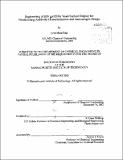| dc.contributor.advisor | K. Dane Wittrup. | en_US |
| dc.contributor.author | Mata-Fink, Jordi | en_US |
| dc.contributor.other | Massachusetts Institute of Technology. Department of Chemical Engineering. | en_US |
| dc.date.accessioned | 2013-06-17T19:46:33Z | |
| dc.date.available | 2013-06-17T19:46:33Z | |
| dc.date.issued | 2013 | en_US |
| dc.identifier.uri | http://hdl.handle.net/1721.1/79194 | |
| dc.description | Thesis (Ph. D.)--Massachusetts Institute of Technology, Dept. of Chemical Engineering, February 2013. | en_US |
| dc.description | Cataloged from PDF version of thesis. "February 2013." | en_US |
| dc.description | Includes bibliographical references. | en_US |
| dc.description.abstract | The sequence diversity of glycoprotein gp120 of the envelope spike of Human Immunodeficiency Virus (HIV) allows the virus to escape from antibody selection pressure. Certain conserved epitopes, like the CD4 binding site, are required for viral fitness and antibodies against these epitopes are able to neutralize HIV from multiple clades. Passive immunization experiments suggest that eliciting such broadly reactive antibodies by vaccination may provide protection, but so far this has proven impossible. In this thesis, we establish a yeast surface display system for the development of gp120-based molecules for antibody characterization and immunogen design. A stripped core gp120 is constructed that retains the correct presentation of the CD4 binding site. Epitopes of several CD4 binding site-directed antibodies, including the gold standard antibody VRC01, are mapped with yeast displayed mutant libraries. A panel of immunogens that share the epitope defined by VRC01 but are diverse elsewhere on their surfaces is designed. Mice immunized sequentially with the diverse immunogens elicit an antibody response that is focused entirely on the VRC01 epitope. The serum cross-reacts with gp120 from multiple clades. Monoclonal antibodies from these mice are isolated and characterized. | en_US |
| dc.description.statementofresponsibility | by Jordi Mata-Fink. | en_US |
| dc.format.extent | 147 p. | en_US |
| dc.language.iso | eng | en_US |
| dc.publisher | Massachusetts Institute of Technology | en_US |
| dc.rights | M.I.T. theses are protected by
copyright. They may be viewed from this source for any purpose, but
reproduction or distribution in any format is prohibited without written
permission. See provided URL for inquiries about permission. | en_US |
| dc.rights.uri | http://dspace.mit.edu/handle/1721.1/7582 | en_US |
| dc.subject | Chemical Engineering. | en_US |
| dc.title | Engineering of HIV gp120 by yeast surface display for neutralizing antibody characterization and immunogen design | en_US |
| dc.title.alternative | Engineering of Human Immunodeficiency Virus gp120 by yeast surface display for neutralizing antibody characterization and immunogen design | en_US |
| dc.type | Thesis | en_US |
| dc.description.degree | Ph.D. | en_US |
| dc.contributor.department | Massachusetts Institute of Technology. Department of Chemical Engineering | |
| dc.identifier.oclc | 844350724 | en_US |
